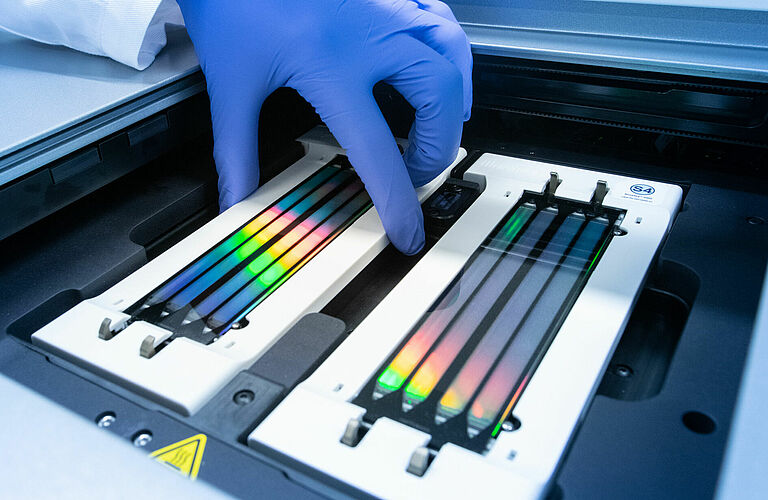Platform foR SinglE Cell GenomIcS and Epigenomics (PRECISE)
Die Einzelzellgenomik verändert gerade grundlegend die Art, wie wir zelluläre Reaktionen in der Homöostase und bei vielen häufigen Krankheiten bestimmen. Tatsächlich kann man sagen, dass die zellulären Landkarten für viele komplexe Organe und Krankheiten neu geschrieben werden.

Platform for Single Cell Genomics and Epigenomics
Die "Platform for Single Cell Genomics and Epigenomics“ (Plattform für Einzelzellgenomik und Epigenomik) ist ein Joint Venture zwischen der Universität Bonn und dem DZNE. Beide Institutionen wollen gemeinsam ihre Expertise auf dem Gebiet der Genomik und Bioinformatik ausbauen. Ein besonderer Fokus liegt auf der Entwicklung und Anwendung von Werkzeugen und Technologien für die Einzelzellgenomik und auf der Bereitstellung dieser Technologien für interne und externe Kooperationspartner.
Die Labore der Plattform befinden sich im neuen DZNE-Gebäude B, die Bioinformatik-Einheit ist am LIMES-Institut angesiedelt. Beide Einrichtungen arbeiten eng zusammen.
Einige der im Rahmen von PRECISE verfügbaren Technologien finden Sie hier:
SMART-seq2 (Picelli et al., 2013, Nat Methods) ist die Einzelzell-RNA-seq (scRNA-seq)-Methode mit der höchsten Empfindlichkeit. Sie ermöglicht die parallele Sequenzierung der Transkriptome von Hunderten von Zellen über die gesamte Transkriptlänge und stützt sich vollständig auf handelsübliche Reagenzien. SMART-seq2 ist die beste Wahl, wenn es um die Untersuchung von Spleißvarianten, SNPs oder monoallelischer Genexpression geht. Die Kosten für die Bibliotheksvorbereitung werden durch die Verwendung einer hauseigenen Version der Tn5-Transposase erheblich gesenkt (Picelli et al., 2014, Genome Research).
FLASH-seq ist eine innovative Methode zur Sequenzierung von Einzelzell-RNA in voller Länge mit hoher Sensitivität, die nur minimale manuelle Eingriffe erfordert, da das Protokoll automatisierungsfreundlich von lysierten Zellen zu gepoolten cDNA-Bibliotheken in weniger als fünf Stunden durchgeführt werden kann (Hahaut et al., 2021, Nat Biotech).
Gleichzeitiges elektrophysiologisches, transkriptomisches und morphologisches Profiling einzelner Zellen (Cadwell et al., 2016, Nat Biotech) auf der Grundlage der Patch-Clamp-Technik und der SMART-seq2-Methode.
PRECISE war der einzige Alpha-Tester in Europa für diese Technologie, die kürzlich von BD Genomics auf den Markt gebracht wurde. Rhapsody basiert auf der CytoSeq-Methode (Fan et al., 2015, Science) und ermöglicht die 3'-End-Sequenzierung von bis zu 50 000 Zellen/Experiment mit gezielten (teilweise) anpassbaren Gen-Panels (500 oder 1000 Gene) oder des gesamten Transkriptoms. Rhapsody verwendet Mikrotiterplatten-Arrays für die Erfassung einzelner Zellen und ist mit einem Bildgebungssystem für die Visualisierung und Zählung von Zellen ausgestattet. Der Preis für die Sequenzierung eines gezielten Panels ist erheblich niedriger, da nicht das gesamte Transkriptom analysiert werden muss. Rhapsody-Proben können gemultiplext werden und/oder Oberflächenproteine können während der RNA-Seq-Methode gleichzeitig quantifiziert werden (Stoeckius et al., 2017, Nat Methods).
Die kommerzielle Emulsionströpfchen-Methode von 10x Genomics ermöglicht es Zehntausende von Zellen parallel auf robuste und reproduzierbare Weise zu analysieren (Zilionis et al., 2017, Nat Protoc).
Die Einzelzelltranskriptomik ist ein sich schnell entwickelndes Feld, in dem regelmäßig neue Methoden zur cDNA-Bibliothekenerstellung und Rechenverfahren eingeführt werden. Es ist daher unerlässlich, mit dem Tempo der technologischen Entwicklung Schritt zu halten. Wir investieren viel Zeit, Personal und technische Ressourcen in die Erprobung und Umsetzung neuer Einzelzelltechnologien sowie in die Entwicklung besserer, schnellerer und kostengünstigerer Methoden, um die modernsten verfügbaren Technologien anbieten und immer komplexere biologische Fragen angehen zu können.
Einige der neuen Technologien, die in Vorbereitung sind, sind im Folgenden aufgeführt:
Charakterisierung von genomischen Regionen mit offenem Chromatin, einem Hilfsmittel zum Auffinden transkriptionell aktiver Genregionen.
Ein "Split-and-Pool"-Verfahren für die 3'-Sequenzierung, das auf einem Ansatz basiert, der die kombinatorische Indexierung und die Tn5-Transposase nutzt (Cao et al., 2017, Science). SciRNA-seq arbeitet mit fixierten Zellen, erfordert keine Einzelzellsortierung und ist leicht auf Tausende von Zellen skalierbar, was die Kosten für die Erstellung der Bibliothek pro Zelle reduziert.
Eine Methode, mit der RNA aus fixierten, permeabilisierten, gefärbten und sortierten Zellen isoliert werden kann, die später mit der Smart-seq2-Methode in eine Sequenzierungsbibliothek umgewandelt wird. Derzeit funktioniert die Methode mit >400 Zellen (Thomsen et al., 2016, Nat Methods).
Die hochpräzise Long-Read Sequenzierung (auch HiFi-Sequenzierung genannt) ermöglicht die Sequenzierung der RNA in voller Länge und trägt dazu bei RNA-Isoformen zu identifizieren, die für die Entstehung von neurodegenerativen Krankheiten oder zur Aufklärung der biologischen Funktionen wichtig sein könnten. Die HiFi-Sequenzierung führt zu mehr Informationen und neuen Anwendungen wie der Sequenzierung von mRNA in voller Länge, der Entdeckung neuer Isoformen, der umfassenden Variantenerkennung oder der gezielten Sequenzierung auf Einzelzellebene (Healey et al., 2022, Genetics).
SHARE-seq ist eine skalierbare Methode die Chromatin-Zugänglichkeit sowie die Genexpression in der selben Einzellzelle gewebeübergreifend zu analysieren. Durch SHARE-seq werden Hochdurchsatz-ATAC als auch RNA-Expression kombiniert und sequenziert (Ma et al., 2020, Cell).
Ausstattung der Plattform
Liquid handling and QC systems
- BioNex Nanodrop II
- Dispendix I.Dot
- SPT Labtech Mosquito x1
- Tecan Freedom EVO
- Roche Lightcycler 480
- Agilent Tapestation 4200
- Agilent Fragment Analyzer
- Thermo Fisher Qubit 3, Flex
NGS library generation
- BD Rhapsody HT Xpress, Scanner and Station
- 10X Genomics Chromium and Chromium iX
- Cytena C.Wash
- Covaris LE220
- Diagenode IP-Star
- Pippin Prep Instrument
Sequencing instruments
- Illumina MiSeq
- Illumina NextSeq 2000
- Illumina NovaSeq 6000
- Illumina NovaSeq X Plus
- PacBio Sequel II
Spatial transcriptomics
- Nanostring GeoMx Digital Spatial Profiler
- 10X Xenium Analyzer





